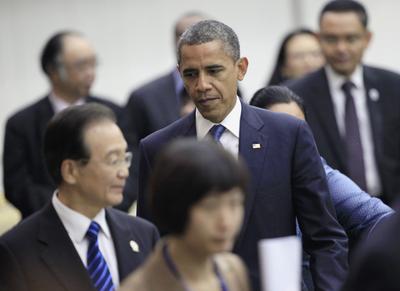The convergence of key actors of varying degrees of influence and size was unprecedented, yet the desired outcome of the diplomatic efforts to manage these clashing interests in Asia is still a long way off. The full impact of the unfolding power game will not be known for some time. What is certain, however, is that something hugely significant has just taken place.
Several dimensions of this power game were at play all at once. Firstly, the world’s most established power, the United States, expanded its ‘pivot’ or strategic rebalancing toward Asia. President Obama’s presence at the seventh East Asia Summit (EAS) in Phnom Penh on 20 November 2012 underscored his self-image as America’s ‘first Pacific president’. Expanding the pivot strategy into Southeast Asia, he revived an old treaty alliance with Thailand; went on a historic visit to Myanmar to prop up that country’s incipient political reform; and symbolically admonished Cambodia for its domestic repression.
The US rebalancing culminated in a direct engagement at the EAS with China — a potential rival and Asia’s next emerging power — which will be led in the next decade by a new leadership whose attitude toward the United States and Southeast Asia remains untested.
The US–China engagement in ASEAN’s backyard was a manifestation of two conflicting goals — competition for influence in Asia by the two powers even as they declared their mutual desire for greater cooperation as the world’s two largest economies. China sees the pivot as an Obama-led ring-fencing of its peaceful rise. China responded to this at the EAS with another push to keep the United States out of Beijing’s South China Sea disputes with several ASEAN states.
Beijing’s assertiveness in shaping the resolution of the South China Sea disputes was the second dimension of the power game. It led to a replay of the proxy tussle and internal divisions within ASEAN caused by host Cambodia’s poor handling of the increasingly divisive issue. For the first time in ASEAN history, the chairman’s draft closing statement had to be openly contradicted and corrected by fellow ASEAN leaders for its ‘inaccuracies’. Hun Sen had wrongly claimed — reflecting his eagerness to please Beijing — that the leaders had reached a consensus not to ‘internationalise the issue’.
The third layer of the power game was the entry of a new race for economic influence and preponderance: ASEAN officially launched the Regional Comprehensive Economic Partnership (RCEP) to pull together Asia’s major economies as one integrated dynamo for growth. The RCEP, a huge free trade area likely to be dominated by China through its sheer size, is a potential rival to the US-led Trans-Pacific Partnership (TPP). Manifesting yet another layer of the diplomatic tussle, China, Japan and South Korea within the RCEP will form their own Northeast Asian free trade area despite current tensions over their maritime disputes in the East China Sea. If successful, their trilateral FTA will overshadow the ASEAN Free Trade Area (AFTA) due to the combined economic weight of the three Northeast Asian economies.
The RCEP is a smart strategic move by ASEAN to offset the projected shortfall of its own ASEAN Community 2015 project at regional integration. With just three years to go, analysts are sceptical of a fully integrated ASEAN community given the foot-dragging by some members over economic liberalisation and the gulf between the more advanced and newer member states.
The emergence of the RCEP, TPP and AFTA alongside the long-standing APEC forum and the future China–Japan–South Korea trilateral FTA is more than coincidental. It reflects what Secretary of State Hillary Clinton described as the strategic power of economic forces — the rise of the ‘economics of power’ and the ‘power of economics’. Though currently competing, the RCEP and TPP could take a positive turn in the long run and end up merging into one big FTA called the Free Trade Area of the Asia Pacific.
The Asian power game can have one of two possible outcomes for ASEAN. Either ASEAN gets trampled underfoot by the more powerful nations, or it survives by maintaining cohesion. What we have just seen at the back-to-back regional summits is ASEAN struggling to steer itself between a rock and a hard place. But the motivation is the same: survival in the face of the growing pressure from competing forces out to shape the evolving architecture in the Asia Pacific.
The inherent weaknesses of ASEAN caused by conflicting interests among members have been exposed once again. Yet, at the same time, their overriding desire to stay on top of the power game is evident. The group has a code-word for this herculean task: ‘ASEAN centrality’.
The battle for ASEAN centrality is hardly over. The EAS in Phnom Penh was just the opening chapter. Over the next few years, especially toward 2015, more drama may unfold as the geostrategic tussle gets more intense and complicated while ASEAN seeks safe passage through the unfolding power game of the giants.
Yang Razali Kassim is Senior Fellow at the S. Rajaratnam School of International Studies (RSIS), Nanyang Technological University, where he also contributes to the Centre for Multilateralism Studies and the Centre for Non-Traditional Security Studies.
A version of this article was first published here as RSIS Commentary No. 217/2012.

